Like many authors, Harry Turtledove references the broad impact film, television, broadcast radio, live theater and their creators (or have had) on society. Sometimes, these references can give a reader insight into how a particular timeline differs from OTL. Other times, they are more incidental and designed to invoke a specific era or culture. What follows is a list of such references which can be found in Turtledove's body of work, organized by the name of the performer, or in cases where a group effort is involved, the title of the work.
Note: As many homages are subtle, they can easily escape the notice of any given reader. Therefore we strongly encourage anyone who has found, or believes he has found, an homage not already on this list, or by an author not represented, to add it.
Douglas Adams
Douglas Noel Adams (11 March 1952 – 11 May 2001) was an English writer and dramatist. He is best known as the author of The Hitchhiker's Guide to the Galaxy, which started life in 1978 as a BBC radio comedy before developing into a "trilogy" of five books that sold over 15 million copies in his lifetime, a television series, several stage plays, comics, a computer game, and in 2005 a feature film.
One of the continuing themes in the Hitchhiker's Guide was the number "42" which was the "Answer to the Ultimate Question of Life, the Universe and Everything" and the different characters searching for "The Question" this was the answer to. In "Someone is Stealing the Great Throne Rooms of the Galaxy" the Omniscient Narrator first describes that there are any number of space drives and then corrects himself and says that there are forty-two, an allusion to Adams' work.
Amos 'n' Andy
Amos 'n' Andy is an American radio and television sitcom set in Harlem, Manhattan's historic black community. The original radio show, which was popular from 1928 until 1960, was created, written and voiced by two white actors, Freeman Gosden and Charles Correll, who played a number of different characters, including the titular Amos Jones (Gosden) and Andrew Hogg Brown (Correll).
When the show moved to television from 1951 and until 1953, black actors took over the majority of the roles; white characters were infrequent. The show is considered a groundbreaking landmark in the history of broadcast performance art, but is also controversial as cultural appropriation, because the white radio actors affected heavy "black" accents to play absurd caricatures.
In "The Last Reunion," Amos 'n' Andy is very popular among the last surviving Confederate veterans in 1932. During an important conference in Richmond, time is taken off for this purpose. John Houston Thorpe and Jed Ledbetter are among the audience.[1]
In The House of Daniel, as Jack Spivey is packing for the road, his neighbor has her radio up so loud that it sounds as if Amos 'n' Andy are in the house with him.[2]
Apollo 13
Apollo 13 is a 1995 American space adventure docudrama film directed by Ron Howard and starring Tom Hanks, Kevin Bacon, Bill Paxton, Gary Sinise, and Ed Harris. The film dramatizes the aborted 1970 Apollo 13 lunar mission, and contains the iconic line "Houston, we have a problem."
In "Topanga and the Chatsworth Lancers", Jared Tillman thinks of the iconic line when anticipating a possible Chatsworth Lancers breach of his Topangan barricade. He was born after men stopped landing on the moon, but remembers seeing the movie in 1995 with a girl named Gail. He realizes that there will be no more lunar expeditions, or movies for that matter, unless the The Change is somehow undone.
Fred Astaire and Ginger Rogers
Fred Astaire (1899-1987) and Ginger Rogers (1911-1995), American actors, dancers, and singers, were iconic dance partners in nine motion pictures made in the 1930s: Flying Down to Rio (1933), The Gay Divorcee (1934), Roberta (1935), Top Hat (1935), Follow the Fleet (1936), Swing Time (1936), Shall We Dance (1937), Carefree (1938), and The Story of Vernon and Irene Castle (1939). They reunited in 1949 for The Barkleys of Broadway, their only color picture. The expression "Fred and Ginger" has become shorthand for an ideal dancing couple. A popular aphorism is that everything Fred Astaire did, Ginger Rogers did backwards and in high heels.
In The House of Daniel, members of the title organization often go to movie houses on their days off. On one occasion they watched a "Fred and Ginger" picture. Given the fantasy analogs which populate the novel, the "Fred" and "Ginger" referenced are probably not Astaire and Rogers.
Josephine Baker
Josephine Baker (born Freda Josephine McDonald, 3 June 1906 – 12 April 1975) was an American-born French entertainer, activist, and French Resistance agent. She was among the most celebrated performers to headline the revues of the Folies Bergère in Paris. Her performance in the revue Un vent de folie in 1927 caused a sensation in Paris. Her costume, consisting of only a girdle of artificial bananas, became her most iconic image and a symbol of the Jazz Age and the 1920s. For her service to Free France in World War II, she was awarded the Croix de guerre and was named a Chevalier of the Légion d'honneur.
In Worldwar: In the Balance, Ken Embry describes the image of Baker's banana dance when observing how much Paris has changed by the time of the Race Invasion of Tosev 3.[3]
Phil Baker
Phil Baker (August 26, 1896 – November 30, 1963) was a popular American comedian and emcee on radio, where he hosted a number of shows. Arguably, his most famous hosting gig was Take It or Leave It, a quiz show that eventually became The $64,000 Question. Baker was also a vaudeville actor who appeared on Broadway a number of times, a songwriter who composed a number of songs, and author. He appeared in a small number films, usually as himself.
In Joe Steele, when Lazar Kagan asks Charlie Sullivan what he knows about uranium, Sullivan recite his admittedly modest knowledge, and then asks Kagan, "How'd I do, Mr. Baker?"[4]
Lucille Ball
Lucille Désirée Ball (August 6, 1911 – April 26, 1989) was an American actress, comedienne, model, film-studio executive, and producer. She was best known as the star of the self-produced sitcom I Love Lucy and its numerous spinoffs, throughout the 1950s.
In the world of Joe Steele, the drastic changes to the timeline of American history did not prevent Ball from achieving television stardom by 1953. How her show's content differs from OTL is not explored.[5]
Brigitte Bardot
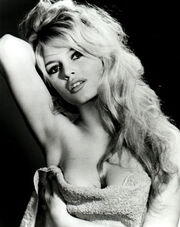
Brigitte Bardot seems to have already fallen out of her clothes.
Brigitte Bardot (born 28 September 1934) is a French actress, former fashion model, singer and animal welfare/rights activist. In 2007, she was named among Empire's 100 Sexiest Film Stars. In recent years, she has become controversial for her stances on animal rights, immigration, and the place of Islam within France.
In Colonization: Down to Earth, a "French chippie who kept trying to fall out of her clothes all the time" stars opposite James Dean in the movie The Battle of Chicago (1964). She played a pretty blonde nurse with an improbably tight and skimpy uniform. While this character fits Bardot's description, her identification is not conclusive.[6]
John Tucker Battle
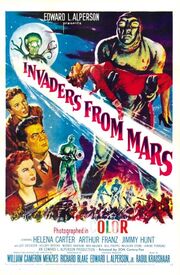
John Tucker Battle wrote the screenplay of Invaders from Mars, a 1953 b-movie about the invasion of a California town by aliens with obvious zippers in their anatomy, which can only be thwarted by the cleverness of a small boy.
In A World of Difference, this film is parodied as Invaders from Minerva.
Samuel Beckett
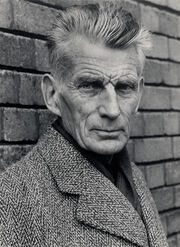
Samuel Beckett's Godot never showed up in "We Haven't Got There Yet," either.
Samuel Beckett was the author of the play Waiting for Godot. The short story "We Haven't Got There Yet" ends with its protagonist, William Shakespeare, about to attend a time-displaced troupe's performance of Waiting for Godot, wondering who Godot is and who might be waiting for him.
Ingrid Bergman
Ingrid Bergman (29 August 1915 – 29 August 1982) was a Swedish three-time Academy Award-winning and two-time Emmy Award-winning actress. She also won the first ever Tony Award for Best Actress in 1947. Her most famous film is Casablanca costarring Humphrey Bogart.
In The Man With the Iron Heart, the McGraw family sees the film The Bells of St. Mary's in 1946 the night before Diana McGraw goes to Washington, DC. Diana knows that her husband, Ed will be staring at the alluring Bergman the entire film.
Milton Berle
Milton Berle, born Mendel Berlinger, also known as "Uncle Miltie" and "Mr. Television" (July 12, 1908 – March 27, 2002) was a comic actor whose career spanned show business from vaudeville, silent films, radio, television, to Broadway and Las Vegas.
Berle's career began at the age of 5 on the streets of upper Manhattan, where he did Charlie Chaplin imitations to entertain other kids. An agent saw him and found work for him as the Buster Brown boy, selling shoes. Chaplin heard about him and sent for him, and he appeared in several silent films with the great Charlie Chaplin. He began in Broadway in 1920 on a musical called "Floradora," then worked vaudeville for awhile. His mother, Sandra, was a great influence on him, and guided him in his early days of show business.
Berle's first credited film was "The Perils of Pauline" (1914) when he was 6, but he was in over 70 films over the course of his lifetime. He successfully made the transition to television in 1948, with The Milton Berle Show, which ran for nearly ten years. (In 1928 he had become one of the first people ever to appear in television by taking part in an experimental broadcast in New York City.) He last acted in 1994, but still made cameo appearances for the last several years. As the New York Times once observed "Television didn't make Milton Berle, Milton Berle made television."
In "The Star and the Rockets", Joe Bauman's viewing of a particularly entertaining episode of Milton Berle's show in January 1954, is interrupted by three three strange men driving an 88 Oldsmobile.
Humphrey Bogart
Humphrey DeForest Bogart (December 25, 1899 – January 14, 1957) was an American actor and cultural icon. After entering film in the 1930s, Bogart's breakthrough came in the 1940s. He starred opposite Ingrid Bergman in Casablanca. That film's supporting actors Sydney Greenstreet and Peter Lorre had previously starred with Bogart in The Maltese Falcon.
Prior to acting, Bogart served in the United States Navy during World War I. During his service, he received the scar to his lip that created his trademark lisp.
In The War That Came Early, Peggy Druce and Dave Hartman watch a new (unnamed) Bogart film in 1943, and find it to be one of Bogart's weaker efforts, but not horrible.[7]
In Southern Victory, an actor identified only as "Humphrey" was popular in American movies in the years leading up to the Second Great War, starring in the movie The Maltese Elephant. Armstrong Grimes called Bogart to mind when he found out his aunt Clara Jacobs was marrying a man named Humphrey Baxter. While this actor isn't identified specifically as Bogart, he's likely a close-enough analog.
Mel Brooks
Mel Brooks (born 1926) is an American film director, screenwriter, composer, lyricist, comedian, actor and producer. He is best known as a creator of broad film farces and comic parodies. The Producers is a musical adapted by Brooks from his 1968 film of the same name. The story concerns two theatrical producers who scheme to get rich by overselling shares in a Broadway flop called Springtime for Hitler. In In the Presence of Mine Enemies where Hitler's Germany won World War II, there is a similar musical about a theater owner who books a terrible play about Churchill and Stalin becoming a smash hit.[8]
Bugs Bunny
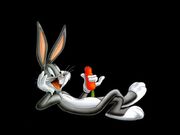
Bugs Bunny, not to be confused with the giant rabbits of "Of Mice and Chicks."
Bugs Bunny is an animated cartoon rabbit, created by Leon Schlesinger Productions (later Warner Bros. Cartoons) and voiced originally by Mel Blanc. Bugs is best known for his starring roles in the Looney Tunes and Merrie Melodies series of animated short films, produced by Warner Brothers. Though a similar character debuted in the WB cartoon Porky's Hare Hunt (1938) and appeared in a few subsequent shorts, the definitive character of Bugs is widely credited to have made his debut in director Tex Avery's Oscar-nominated film A Wild Hare (1940).
In Colonization: Down to Earth, Jonathan Yeager and Karen Culpepper go to a Los Angeles drive-in theater. They watch a cartoon where a "rascally rabbit" evades both human and Lizard hunters, just before the main feature The Battle of Chicago begins. While the rabbit is unnamed, his brief description is clearly meant to bring Bugs Bunny to mind.[9]
James Cameron
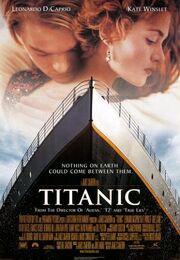
Truth may be stranger than fiction, but fiction has better production values.
In "Before the Beginning" we learn that James Cameron's 1997 film Titanic is more interesting than time-viewer recordings of the sinking of the actual ship.
Sid Caesar
Isaac Sidney "Sid" Caesar (September 8, 1922 – February 12, 2014) was an American comic actor and writer, best known for two pioneering 1950s live television series, Your Show of Shows and its successor Caesar's Hour, both of which influenced later generations of comedians. Caesar also acted in movies including It's a Mad Mad Mad Mad World (1963) and Grease 2 (1982).
In the world of Joe Steele, Caesar has still achieved television stardom by 1953.[10]
Casablanca
Casablanca (1942) is an American romantic drama film directed by Michael Curtiz, from a screenplay which went through several revisions by various writers. It stars Humphrey Bogart, Ingrid Bergman and Paul Henreid, and features Claude Rains, Conrad Veidt, Sydney Greenstreet and Peter Lorre. It is set in the Vichy-controlled city of Casablanca, Morocco during World War II, and focuses on a man's conflict between (in the words of one character) "love and virtue": He must choose between his love for a woman and doing the right thing, helping her and her husband, a Czechoslovakian Resistance leader, to escape from Casablanca to Portugal to continue his fight against the Nazis.
The films is full of frequently quoted and misquoted lines, which have permeated pop culture. Perhaps the most famous is "Play it again, Sam," most often attributed to Bogart. In fact, Bergman speaks the line and it is simply "Play it, Sam." The inaccuracy of the quote has often been used as comedy fodder.
In The Two Georges Colonel Thomas Bushell walks into the lounge of the Empire Builder and hears his adjutant Samuel Stanley playing "I Remember Your Name" on the piano. Stanley abruptly stops when he sees Bushell since it was his and Irene's (his ex-wife) song but Bushell tells him to "... play it, Sam".[11] Later in the novel, another character makes an allusion to another Bogart picture.
In The Man With the Iron Heart, the Casablanca line "round up the usual suspects" is quoted by NKVD agent Vladimir Bokov at one point.
Charlie Chaplin
Sir Charles Spencer "Charlie" Chaplin, KBE (16 April 1889 – 25 December 1977) was an English comic actor, film director and composer best known for his work in the United States during the silent film era. He became the most famous film star in the world before the end of World War I. Chaplin used mime, slapstick and other visual comedy routines, and continued well into the era of the talkies, though his films decreased in frequency from the end of the 1920s. His most famous role was that of The Tramp, which he first played in the Keystone comedy Kid Auto Races at Venice in 1914.
Chaplin is referenced several times throughout Turtledove's work. In West and East, for example, Theo Hossbach returns to his encampment in an uproar, and watches two panzer crewmen bounce off each other as though they were doing slapstick in a Chaplin film.[12] In Two Fronts, Peggy Druce reflects that Chaplin, in contrast to Adolf Hitler, grew his toothbrush mustache for comic effect.[13]
Cheech and Chong
Cheech & Chong are a Grammy Award–winning comedy duo consisting of Richard "Cheech" Marin and Tommy Chong who found a wide audience in the 1970s and 1980s for their films and stand-up routines, which were based on the hippie and free love era, and especially drug and counterculture movements, most notably their love for cannabis.
One of their most famous routines is called "Dave", in which Dave (Cheech) tries to gain entrance into an apartment after having purchased marijuana. However, the occupant (Chong) is implicitly under the influence already, and repeatedly answers that "Dave's not here", completely misinterpreting Dave's requests to be let in.
In "The Mammyth", the protagonists encounter a a Walrus and a Carpenter. When Tremendous Ptarmigan asks them if they'd seen "Dave", the Carpenter quickly answers "Dave's not here."
Gary Cooper
Frank James "Gary" Cooper (May 7, 1901 – May 13, 1961) was an American film actor. He was renowned for his quiet, understated acting style and his stoic, individualistic, emotionally restrained, but at times intense screen persona, which was particularly well suited for the many Westerns he made.
In Days of Infamy, Cooper's films are among those available in Hawaii after the Empire of Japan conquered the territory in 1942, including many of his Westerns. Despite the fact that Cooper usually played the quintessential American hero, the Japanese soldiers enthusiastically cheer him on as he battles "savage" Amerindians.[14]
In "Must and Shall", Cooper's image is named as the ideal for a man of the FBS.
Beverley Cross
Beverley Cross wrote the screenplay for the 1965 film Genghis Khan, starring Omar Sharif as Temujin, Genghis Khan.
This film features in the short story "The Barbecue, the Movie, & Other Unfortunately Not So Relevant Material." In the story, the movie, which is imperfectly faithful to known details of Khan's biography, is viewed by a historian from the distant future, which presumably will lead to inaccurate knowledge of Khan's life in the historian's time.
Gerard Damiano
Gerardo Rocco "Gerard" Damiano (August 4, 1928 – October 25, 2008) was an American director of adult films. He wrote and directed the 1972 cult classic Deep Throat and the 1973 the smash hit The Devil in Miss Jones (whose title was taken from the 1940 romantic comedy The Devil and Miss Jones). These films are considered to have elevated pornographic films to a form of art, and Damiano is one of the seminal directors of what is known as The Golden Age of Porn.
In the Atlantis story "The Scarlet Band," Athelstan Helms, while investigating murder suspect Samuel Jones, recites the truism "the devil is in the details." Dr. James Walton replies "Do you suppose the devil is in Mr. Jones?"[15]
Walt Disney
Walt Disney (1901-1966) was an American cartoonist, movie producer and businessman who revolutionized the animated film and the theme park industry. Mickey Mouse and Donald Duck are some of his more famous mascots.
In the Worldwar series, two Lizards raised by humans are named Mickey and Donald, an obvious reference, which even causes some characters in the series to chuckle. In an unrelated chapter of Down to Earth, the POV character Dr. Reuven Russie watches a Donald Duck cartoon in a cinema and thinks it's just about the funniest thing he's ever seen.
In "The Weather's Fine", Tom Crowell notices a poster of Mickey and Minnie Mouse doing something obscene on the wall of Barefoot Sounds.[16]
In The Disunited States of America, Beckie Royer is a fan of The Breeze in the Birches, the novel which inspired Mr. Frog's Crazy Ride at Mortimer's World.[17] This is a play on Mr. Toad's Wild Ride at Disney's theme parks, based on Kenneth Grahame's The Wind in the Willows. Mortimer Mouse was Disney's working name for the character that became Mickey; he decided that sounded too highbrow and changed it to a more "street" name, later reassigning the name Mortimer to a high-faluting bully who bothers Mickey in some of the early cartoons.
Mr. Toad's Wild Ride is also referenced in A World of Difference.[18]
In "Of Mice and Chicks," Lani's giant rabbit is named Thumper, after the rabbit created for Disney's 1942 movie Bambi (based on an Austrian novel which featured no such character).
Geraldine Farrar
Geraldine Farrar (February 28, 1882 - March 11, 1967) was an American soprano opera singer and film actress, noted for her beauty, acting ability, and "the intimate timbre of her voice." She had a large following among young women, who were nicknamed "Gerry-flappers". In 1915, she starred in a silent film of the French opera Carmen.
In The Great War: Walk in Hell, Herman Bruck invites Flora Hamburger to see Farrar in a "moving picture" version of Carmen with him, but she declines.[19]
W.C. Fields
W.C. Fields was the stage name of William Claude Dukenfield (January 29, 1880 – December 25, 1946), an American comedian, actor, juggler and writer. Fields' comic persona was a misanthropic and hard-drinking egotist, who remained a sympathetic character despite his snarling contempt for dogs and children. His catchphrase, which varied in its precise wording, is usually remembered as "All in all, I'd rather be in Philadelphia," referring to his birth city.
The Philadelphia line is uttered in chapter 10 of The Two Georges by Thomas Bushell.
John Fletcher
John Fletcher was a younger contemporary of William Shakespeare and is widely believed, though not known, to have collaborated with the Bard on several of his final plays (namely Henry VIII, The Two Noble Kinsmen, and Cardenio).
Fletcher wrote the play Bonduca, which tells the story of Boudicca. Most of the lines found in the fictional Shakespearean play Boudicca are taken from Bonduca; however, the play itself bears only a distant resemblance to the play Turtledove invented for Ruled Britannia.
Also, lines are lifted from Shakespeare's Henry VIII to pad out both Boudicca and King Philip, which is appropriate given Fletcher's suspected hand in Henry VIII.
Cary Grant
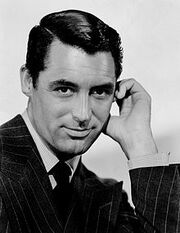
No mere mortal can withstand the infinite sex appeal of Cary Grant.
Cary Grant (born Archibald Leach on January 18, 1904, died November 29, 1986) was a British-born American film actor active from 1932 through 1966. He was twice nominated for Oscars for Best Actor (in 1942 for Penny Serenade and 1945 for None But the Lonely Heart), and for five Golden Globes. However, he was frequently passed over at awards shows. His only major honor was a Lifetime Achievement Award, given at the 1970 Academy Awards.
In The War That Came Early: Coup d'Etat, when Joe Orsatti fails to charm a cocktail waitress at the Hibiscus Blossom in Honolulu, Pete McGill reflects that his comrade-in-arms did not compare favorably with Grant in terms of sex appeal.[20] In Colonization: Second Contact, Barbara Yeager is disappointed that Grant is not in attendance at a fundraising event.[21]
Matt Groening

*I will not claim that The Simpsons appear in TL-191 *I will not claim that The Simpsons appear in TL-191 *I will not claim that The Simpsons appear in TL-191 *I will not claim that The Simpsons appear--
Matt Groening is the creator of the successful cartoon The Simpsons. Simpson was also the middle name of General Ulysses S. Grant. In the The War Between the Provinces series, a Grant analog is a major character. The character is named Bart in honor of Bart Simpson.
(Grant's first name, Ulysses, is the Latinized version of Odysseus, who was of course immortalized in Homer's Odyssey. However, Turtledove has not pursued a pun based on Homer Simpson.)
In Supervolcano: Eruption, Rob Ferguson thumped his forehead and said "D'oh" when he realized the cat he saw at the Trebor Mansion Inn was a Maine Coon. He reflected he was acting as though he had escaped from a Simpsons episode.[22]
Christopher Guest

The supervolcano goes up to eleven, man
Christopher Guest is most widely known for having written, directed and starred in several improvisational "mockumentary" films that feature a repertory-like ensemble cast. The first of these, This Is Spinal Tap, had Guest playing Nigel Tufnel, lead guitarist of the band whose amplifier control knobs all have the highest setting of eleven. When Yellowstone National Park was hit by a series of magnitude 7.0 earthquakes just before the supervolcano erupted, Kelly Birnbaum wondered what a full eruption would feel like and thought "goes up to eleven, man" in a direct reference to Spinal Tap.[23]
Alec Guinness
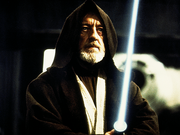
"You don't need to see President Cavanaugh's identification. Michelle Gordian isn't the author you're looking for."
Sir Alec Guinness (2 April 1914 – 5 August 2000) was an English actor. After an early career on the stage, he was featured in the Ealing Comedies series which included The Ladykillers (1955). He is also known for his roles in six period dramas directed by Sir David Lean, including Bridge on the River Kwai (1957), for which he won the Academy Award for Best Actor. But in popular culture he is best known as Jedi Master Obi-Wan Kenobi in the Original Star Wars Trilogy (1977-1983), receiving a nomination for an Academy Award for Best Supporting Actor.
In "Hindsight," set in 1953, central character Pete Lundquist watches a time-displaced copy of Star Wars: A New Hope, which was filmed in 1976 and released in 1977. Although Lundquist is awed by the vast improvement in film visuals from the 1950s to the 1970s, the biggest impression left on him is of how the years took their toll on Alec Guinness, which makes him contemplate his own mortality.[24]
Rita Hayworth
Rita Hayworth (born Margarita Carmen Cansino; October 17, 1918 – May 14, 1987) was an American actress and dancer. She achieved fame during the 1940s as one of the era's top stars, appearing in a total of 61 films over 37 years. The press coined the term "The Love Goddess" to describe Hayworth after she had become the most glamorous screen idol of the 1940s. She was the top pin-up girl for GIs during World War II.
Worldwar's fictional version of historical soldier Leslie Groves seems to be obsessed with Rita Hayworth. In Tilting the Balance, he tells a joke that if duty required him to repudiate his wife and marry Rita Hayworth, he would do it willingly, but Rita might not be pleased with him. Then in Upsetting the Balance, Groves says that the curves of the Fat Lady (the bomb which will be a turning point in the Race Invasion of Tosev 3) are as beautiful as Rita Hayworth's.
Jim Henson

Jim Henson (1936-1990) was an American cartoonist and filmmaker, best known for his innovation of combining marionettes and puppets into "Muppets," designed to be especially flexible and full of emotion. Henson's signature character was Kermit the Frog, who appeared in the television programs Sesame Street and The Muppet Show, as well as feature motion pictures.
In Turtledove's The War Between the Provinces series, a posthumously referenced character based on Napoleon I of France is named Kermit, an allusion to the insulting English custom of referring to the French as the Frogs.
"The Mammyth" the main character, Tundra Dawn, is referred to as a "Muppetoid" and is apparently based on Prairie Dawn. Her two companions on a quest for the possibly mythical "mammyth" are inspired by Big Bird and Grover, while the mammyth itself is based on Snuffleupagus. All are Henson (or associates') creations.
In the opening chapter of Household Gods, Nicole Gunther turns on Sesame Street for her children as part of their daily routine.
Katharine Hepburn
Katharine Houghton Hepburn (May 12, 1907 – June 29, 2003) was an American actress. Known for her fierce independence and spirited personality, Hepburn was a leading lady in Hollywood for more than 60 years. She appeared in a range of genres, from screwball comedy to literary drama, and she received four Academy Awards for Best Actress — a record for any performer. In 1999, Hepburn was named by the American Film Institute as the greatest female star of Classic Hollywood Cinema.
In The Hot War: Bombs Away, Aaron Finch and Jim Summers deliver a refrigerator to a Mrs. O'Byrnne in Torrance, and Summers comments on the customer's resemblance to Katharine Hepburn.[25] A few months later, while improbably watching The African Queen, Finch does see the resemblance Summers had noticed.[26]
Bob Hope
In addition to his mildly significant political stance in "News From the Front", Bob Hope is referenced throughout Turtledove's work. For example, in Colonization: Second Contact, American astronaut Glen Johnson hears some of the transmissions between the Race's Colonization Fleet (which had expected a fully conquered planet) and Race bases on Earth, and concludes that Bob Hope couldn't be half as funny as those transmissions if he tried for a year.[27]
Characters in multiple timelines have compared Richard Nixon's nose to Bob Hope's.
Danny Kaye
Danny Kaye (born David Daniel Kaminsky, January 18, 1911 – March 3, 1987), was an American actor, singer, dancer, comedian, and musician. His performances featured physical comedy, idiosyncratic pantomimes, and rapid-fire novelty songs.
In The Man With the Iron Heart, Howard Frank responds sardonically to Lou Weissberg's bad joke by telling him he's a comedian like Danny Kaye.[28]
King Kong
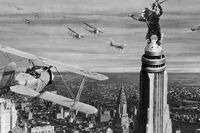
Wait until you face Messerschmitts
King Kong is a 1933 American fantasy monster adventure film directed and produced by Merian C. Cooper and Ernest B. Schoedsack. The screenplay by James Ashmore Creelman and Ruth Rose was from an idea conceived by Cooper and Edgar Wallace. The film tells of a gigantic, prehistoric, island-dwelling ape called Kong who is taken to New York City and dies in an attempt to possess a beautiful young woman while atop the Empire State Building. Kong is distinguished for its stop-motion animation by Willis O'Brien and its musical score by Max Steiner. It has been remade twice: in 1976 and in 2005.
Many sources cite King Kong as one of Adolf Hitler's two favorite films (the other being Snow White and the Seven Dwarfs).
In The War That Came Early: Last Orders, Aristide Demange and Louis Mirouze discuss King Kong. Mirouze mentions how the biplane fighters in the film had been as good as anybody's in 1933 but wouldn't last ten minutes against modern aircraft.[29]
Ernie Kovacs
Ernest Edward "Ernie" Kovacs (January 23, 1919 – January 13, 1962) was an American comedian, actor, and writer. Kovacs' visually experimental and often spontaneous comedic style influenced numerous television comedy programs for years after his death in an automobile accident. Some of Kovacs' unusual behaviors include having pet marmosets and wrestling a jaguar in his TV studio in Philadelphia. Kovacs was posthumously awarded the 1962 Emmy for outstanding electronic camera work and the Directors' Guild award. In the 1980s, he was inducted into the Academy of Television Arts & Sciences Hall of Fame. Kovacs also has a star on the Hollywood Walk of Fame for his work in television.
The common Hungarian name Kovacs is pronounced Kovach in Hungarian, however most English-speakers, Ernie himself included, pronounce it Kovax.
In The Hot War: Armistice, the linguistic matter of Kovacs/Kovach/Kovax is one of the many culture shocks which Hungarian soldier Istvan Szolovits learns in his education about America. When hearing that Kovacs is called Kovax by everyone in America, Szolovits thinks of his encounter with American soldier Imre Kovacs, who uses the Hungarian pronunciation.
L.A. Law
L.A. Law is an American television legal drama series that ran for eight seasons on NBC, from September 15, 1986, to May 19, 1994. Created by Steven Bochco and Terry Louise Fisher, it contained many of Bochco's trademark features including an ensemble cast, large numbers of parallel storylines, social drama, and off-the-wall humor. It reflected the social and cultural ideologies of the 1980s and early 1990s, and many of the cases featured on the show dealt with hot-topic issues such as capital punishment, abortion, racism, gay rights, homophobia, sexual harassment, AIDS, and domestic violence. The series often also reflected social tensions between the wealthy senior lawyer protagonists and their less well-paid junior staff. The show won 15 Emmy Awards throughout its run, four of which were for Outstanding Drama Series.
In Household Gods, Nicole Gunther began working for Rosenthal, Gallagher, Kaplan, Jeter, Gonzalez, & Feng in Los Angeles in 1993, dreaming that her life would be glamorous and exciting like the L.A. Law characters lived. Six years later, she was disappointed by the reality.
John Lasseter
John Alan Lasseter (born January 12, 1957) is an American animator and film director, who is the chief creative officer of Pixar Animation Studios, Walt Disney Animation Studios, and DisneyToon Studios. He is also the Principal Creative Advisor for Walt Disney Imagineering. Among other works, Lasseter wrote the basic storyline of Toy Story, a 1995 fantasy comedy adventure film about sentient toys, which he also directed.
In Household Gods, Kimberley Perrin watches a videotape of Toy Story while ailing from an unidentified virus. The ailing Kimberley is barely conscious of the humorous antics of Sherriff Woody and Buzz Lightyear on the screen, which would have her roaring with laughter at a better time.
Laurel and Hardy
Laurel and Hardy were one of the most popular and critically acclaimed comedy double acts of the early Classical Hollywood era of American cinema. Composed of thin English immigrant Stan Laurel (born Arthur Jefferson, 16 June 1890 – 23 February 1965) and fat American Oliver Hardy (January 18, 1892 – August 7, 1957), they became well known during the late 1920s to the mid-1940s for their slapstick comedy. In the film shorts, Hardy often said to Laurel: "Well, this is another fine mess you've gotten us into!"
In The War That Came Early: West and East, Sgt. Albert Dieselhorst tells his superior, Hans-Ulrich Rudel: "Well, sir, here's another fine mess you got me into". Rudel recognizes the line's source and responds "As long as we keep getting out of them."[30]
Gypsy Rose Lee
Gypsy Rose Lee (born Rose Louise Hovick, January 8, 1911 – April 26, 1970) was an American actress and burlesque entertainer famous for her striptease act. She was also an author of fiction, non-fiction, and plays.
In Joe Steele, on observing the unenthusiastic crowd at President Joe Steele's second inauguration on the cold, miserable afternoon of January 20, 1937, Charlie Sullivan muses that "nobody except perhaps Gypsy Rose Lee would be able to excite this crowd, and Gypsy Rose Lee would freeze to death if she came out in what she usually almost wore."[31]
David Letterman
In addition to his largely uncatalogued role in the obscure piece "A Different Vein," David Letterman has an existential reference in "Deconstruction Gang." The main character forgoes watching Letterman's late-night show, to prepare for his early-morning debut with Gang 4.[32]
Richard Levinson and William Link
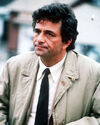
Peter Falk as Columbo. Not to be confused with Garanpo or Maria Peterfalvy.
Richard Levinson and William Link were a pair of mid-20th century American television writers. They created, among other programs, the crime drama Columbo, and correspondingly created the title character (played by Peter Falk) as well. This character provided the inspiration for the character Garanpo in Homeward Bound. Also, a TV Reporter in Supervolcano: Eruption mispronounces the name of Maria Peterfalvy as "Mrs. Peterfalk".
The Lone Ranger
The Lone Ranger is a fictional crimefighting vigilante who roams the American Old West with his Apache friend, Tonto. The character has been called an enduring icon of American culture. First appearing in 1933 in a radio show, the character spun out into books film, and television. Arguably the best known version is the television show that ran from 1949 to 1957.
In Days of Infamy, Oscar van der Kirk listened to The Lone Ranger on the radio in California before moving to Hawaii where the program is not broadcast. During the invasion of Hawaii, Susie Higgins is terrified that "we" are in a lot of danger. Oscar is tempted to reply with Tonto's alleged line "What do you mean we, Kemo Sabe?" but then realizes that by bedding Susie, he has become responsible for her.[33]
Bela Lugosi
Béla Lugosi (born Béla Ferenc Dezső Blaskó, 20 October 1882 – 16 August 1956) was a Hungarian actor of stage and screen. He is most remembered for his various roles in American horror films. His name is virtually synonymous with the vampire Dracula (created by Bram Stoker), whom Lugosi played first on Broadway, and then on film in Dracula (1931) and Abbott and Costello Meet Frankenstein (1948). Arguably, his second most famous role is Ygor, the obsessed laboratory assistant from Son of Frankenstein (1939) and Ghost of Frankenstein (1942).
In the Worldwar series, American soldier Bela Szabo is nicknamed "Dracula" for sharing his first name with Lugosi.
In The War That Came Early: Hitler's War, Chaim Weinberg, an American volunteer with the Lincoln Brigade in Spain, frequently comes into contact with Hungarian volunteers whose accents remind him of Lugosi's speaking voice.[34] While stationed in Siberia in 1939, Sgt. Hideki Fujita calls the mosquitoes that plagues his unit "Draculas" in reference to the original Lugosi film.[35]
Ygor is the basis of the character Igor in "Father of the Groom".
See also
The Marx Brothers
In addition to their central role in "Hail! Hail!," the Marx Brothers - Chico, Harpo, Groucho, Gummo, and Zeppo - are referenced fleetingly in numerous Turtledove works.
In Supervolcano: All Fall Down, when the salvage crew which includes Vanessa Ferguson arrives in Fredonia, Kansas, she begins to sing "Hail, Hail, Freedonia" from the Marxes' Duck Soup, much to the annoyance of her teammates.[36]
In The War That Came Early: The Big Switch, Pete McGill mocks communism by attributing it to Groucho Marx rather than Karl Marx.[37]
In The Man With the Iron Heart, Howard Frank responds sardonically to Lou Weissberg's bad joke by telling him he's a comedian like Groucho Marx.[38]
In Worldwar: Tilting the Balance, Leslie Groves surmises that Joshua Sumner, sheriff of the hick town of Chugwater, has gotten all his ideas of how Italians are supposed to be behave, by watching Chico Marx.[39]
In Southern Victory there is a popular vaudeville troupe called The Engels Brothers who make a few brief appearances in different volumes. Their name is a metatextual in-joke, as Friedrich Engels was the writing partner of Karl Marx.
Shigeru Miyamoto

"Of course we are communist truck drivers!"
Shigeru Miyamoto (b. 1952) is a Japanese video game designer. Among his more famous creations are Mario & Luigi, small mustached twin brothers who work as plumbers when not rescuing people who have been kidnapped by evil creatures in the colourful fairy tale world of Mushroom Kingdom. These characters have transitioned from video games to other media.
In The Gladiator, Crosstime employees plant a cover story in Gianfranco Mazzilli's mind so he can explain his long absence to the Security Police. Part of it involves hitching a ride with two truckers named Mario and Luigi, who were hauling mushrooms.[40]
Marilyn Monroe
Marilyn Monroe (born Norma Jeane Mortensen, later called Norma Jean Baker, June 1, 1926 - August 5, 1962) was an American actress, singer, and model. She has become an icon of 1950s Hollywood. She was married three times, including one marriage to baseball player Joe DiMaggio. Persistent rumor also has it that Monroe engaged in affairs with President John F. Kennedy and his younger brother Robert.
In her last years, Monroe earned a reputation as a being temperamental and difficult. There is also evidence of physical and mental health problems. She died on August 5, 1962 of a fatal drug overdose. Officially ruled a "probable suicide", speculation persists that it was either accidental, or an act of murder.
In "A Massachusetts Yankee in King Arthur's Court", John F. Kennedy mentally likens his quick dalliance with Queen Guinevere to his relationship to Marilyn Monroe . Both women were icons of sexuality, and the opportunity to have sex with each was too good to pass up.
Anne Nichols
Anne Nichols (November 26, 1891 – September 15, 1966) was an American playwright. Among her most famous works was the farce Abie's Irish Rose, which centers on the marriage of a Jewish man to an Irish woman. In Joe Steele, Jewish-American Esther Sullivan muses to her Irish-American husband Charlie that they are right out of Abie's Irish Rose, except with the genders reversed.[41]
Dudley Nichols
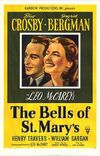
You've obviously never been neck deep in nuns.
Dudley Nichols wrote the screenplay of The Bells of St. Mary's, which features in The Man With the Iron Heart.
Gwyneth Paltrow
Gwyneth Paltrow (born September 27, 1972) is an Academy Award-winning American film actress who has played roles including Thomas Jefferson's daughter, and a fictitious lover of William Shakespeare in a role written by Tom Stoppard.
In In High Places, set in 2096, Annette Klein uses the name of long-ago film actress Gwyneth Paltrow as an alias in order to escape from the offices of an illegal Crosstime Traffic station in Madrid. Subsequently passing a monument to victims of terrorism who were killed in the year 2004, she muses that that was during the time when Paltrow was making movies.
Trey Parker and Matt Stone
Trey Parker (b. 1969) and Matt Stone (b. 1971) are Colorado cartoonists and comic actors in television and cinema, and also writers of theatrical plays. They are best known for their animated series South Park, first aired in 1997. Justin Kloster, hero of two Turtledove stories, is by his own admission a South Park fan.
Gregory Peck
Gregory Peck (April 5, 1916 - June 12, 2003) was an American stage and film actor. He is best remembered for playing the role of Atticus Finch in the film adaptation of Harper Lee's To Kill a Mockingbird. For this role he won the 1962 Academy Award for Best Actor.
Peck, a Democrat, was active in a number of left-leaning political and social causes, but declined to run for office himself.
Peck died of broncopneumonia on June 12, 2003 at the age of 87.
In The War That Came Early: Coup d'Etat, when Joe Orsatti attempts to charm a cocktail waitress at the Hibiscus Blossom in Honolulu, Pete McGill reflects that his comrade-in-arms did not compare favorably with Gregory Peck in terms of sex appeal.[42]
Rambo movies
Rambo is a series of four films (1982, 1986, 1988, 2008) about an American soldier named John James Rambo (born July 6, 1947) who fights in the Vietnam War, the Soviet war in Afghanistan, and other conflicts where he protects the downtrodden and destroys evil in an over-the-top, larger-than-life manner. The first movie was loosely based on the 1972 novel First Blood by David Morrell, and the later films all used original stories. The slang term "Rambo" has entered the language to describe a person who is reckless, disregards orders, uses violence to solve problems, enters dangerous situations alone, and is exceptionally tough and aggressive.
In "Black Tulip", Vladimir, a Soviet soldier in Afghanistan (the setting of Rambo's third movie in 1988), says "You see Rambo out there? I sure don't," to which his comrade Sergei replies "We've got our own Ramboviki right here."[43] Incidentally, the collection Redshift which features this story, and the follow-up collection, Flights: Extreme Visions of Fantasy which features "Coming Across", also contain stories by Rambo's creator David Morrell.
Dan Rather
Daniel Irvin "Dan" Rather, Jr. (born October 31, 1931) was an anchor of the CBS Evening News for 24 years, from March 9, 1981, to March 9, 2005.
In "Designated Hitter", Dr Strangeglove says that the ambassador from the Confederacy of Sentient Beings has "a presence Dan Rather would kill for."[44]
Leni Riefenstahl
In addition to her more relevant roles in Turtledove's work, Leni Riefenstahl and her (in)famous propaganda film, Triumph of the Will, are referenced throughout his Nazi-related work. In The Man With the Iron Heart, her work is described as having made a substantial impression on the Americans who occupy Germany after World War II.[45][46]
Rocky and Bullwinkle cartoons
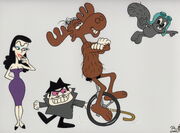
Crosstime Traffic discovered an alternate where the Soviet Union was supplanted by "Pottsylvania."
Rocket "Rocky" Jay Squirrel and Bullwinkle Jay Moose were two anthropomorphic animal everymen who appeared in a series of television cartoons in the early 1960s, where the duo repeatedly went on exotic adventures, faced off against two bumbling enemy spies, made insightful jokes about current events, and broke the fourth wall. In The Valley-Westside War, two fugitive-hunting bloodhounds are named Rocky and Bullwinkle.
In Supervolcano: All Fall Down, Rob Ferguson was out hunting for moose and reflected on some of the stranger things he had eaten since the Yellowstone Supervolcano had erupted, such as squirrels and robins. He then thought about the DayGlo orange vest he was wearing to warn other hunters that he wasn't a moose or squirrel or any other refugee from The Rocky and Bullwinkle Show.[47] The other members of Squirt Frog and the Evolving Tadpoles also liked Rocky and Bullwinkle and referred to any fan mail they received as "flounders" from a line from the show: "Fan mail ... from a flounder".[48]
Robert Rodat
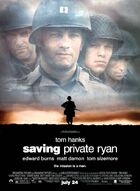
Captain Miller urged Private Ryan to "Earn it." So as a much older man he made The Curse of Rhodes, semi-pornographic fun for the whole family. I'd say he earned it.
Robert Rodat was the screenwriter for the World War II film Saving Private Ryan. Homage is paid to this movie in Homeward Bound when a number of characters watch a movie about the Race Invasion of Tosev 3 called Rescuing Private Renfall.
Incidentally, Homeward Bound also features a cameo appearance by Matt Damon, who played the title character in Saving Private Ryan.
Gene Roddenberry
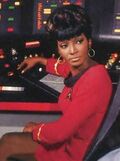
Wait--You want a character named after me and based on Uhura to do something important? Damn, why couldn't you have come along 45 years ago?
Gene Roddenberry (1920-1991) was the original creator of the successful science fiction franchise Star Trek. Among the original characters Roddenberry created for this franchise is Nyota Uhura, who was played by Nichelle Nicholls from 1966 to 1991. In the Worldwar franchise's final novel Homeward Bound, a character matching Uhura's description is given the name Nicole Nichols. A possible additional reference comes in the series' first novel, when Jens Larssen's first scene includes the statement "He was a physicist, damn it, not a carpenter." This sentence bears a strong resemblance to a repeated line of Dr. Leonard McCoy, which never had the same wording twice: "I'm a doctor, damn it, not a bricklayer, engineer, magician" or some other alternative.
The short work "Half the Battle" was first published in Stardate, a magazine that served as a resource for science fiction role playing games, with an emphasis on the Star Trek RPG. "Half the Battle" incorporates a few references to Star Trek, as a post apocalyptic society sets about reclaiming technology. At the end, the society has built a starship based, implicitly, on designs from a Star Trek guidebook. On the ship's maiden voyage, the commander orders Warp 3, musing that the ship won't "go so boldly" yet, a parody of Star Trek's grammatically questionable motto "to boldly go where no man has gone before."
In Supervolcano: All Fall Down, Dr. Travis Suzuki, Louise Ferguson's OB-GYN was an Asian-American whose appearance and behavior remind her of Mr. Sulu from Star Trek.[49]
Will Rogers
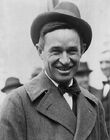
Now you know that Will Rogers appears in Southern Victory, so lord it over your friends. After all, an ignorant person is one who doesn't know what you have just found out.
The fate of journalist Will Rogers in the Southern Victory timeline is alluded to in The Victorious Opposition when one of his signature catchphrases is seen as a popular quotation throughout North America: "All I know is what I read in the papers."
In the novel Joe Steele, Rogers' quote that "I am not a member of any organized political party, I am a Democrat" is recalled by reporter Charlie Sullivan while covering the Democratic Party Convention in Chicago. Sullivan was reflecting on the chaotic mass of delegates and reporters at the convention. Shortly after, Sullivan also thought that the two-thirds rule added to the disorder by making it difficult to choose the Party's Presidential nominee.[50]
Jane Russell
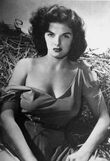
Truly an "expensive bust".
Ernestine Jane Geraldine Russell (June 21, 1921 – February 28, 2011) was an American film actress and was one of Hollywood's leading sex symbols in the 1940s and 1950s.
In "News From the Front", a fictional The New Yorker articles declares the Mark XIV Torpedo to be the US Navy's answer to Jane Russell, an "expensive bust."[51]
William Shakespeare
See Shakespearean References in Turtledove's Work
Sophocles
Sophocles or Sophokles (circa. 496 BC - 406 BC), Σοφοκλῆς in Greek, was one of three great Ancient Greek tragedians. He was preceded by Aeschylus, and was followed by or contemporary to Euripides. According to the Suda, a 10th century AD Byzantine encyclopedia, he wrote 123 or more plays during the course of his life. Of those, only seven of his tragedies have survived into modern times with their text completely known. Arguably, the most famous of these are the plays concerning the Theban royals Oedipus and Antigone.
In "Death in Vesunna", Sophocles' lost play Aleadai was one of the treasures which time-traveling criminals Lou Muller and Mark Alvarez attempted to obtain from the year AD 147.[52]
Steven Spielberg
Steven Spielberg is a prolific and innovative director and producer of films. This includes his 1993 adaptation of the Michael Crichton novel Jurassic Park, about dinosaurs being resurrected by modern science.
In "Before the Beginning", we learn that time-viewer videos of Utahraptor dinosaurs were even more exciting than Spielberg's film.
In The Hot War: Fallout, a shortage of modern tanks has caused the Soviet Union to throw weak, obsolete models into combat. POV character Konstantin Morozov sees a gathering of these antiquated machines and thinks of them as a "Jurassic tank park."[53]
Tom Stoppard

Tom Stoppard, whom Turtledove seems quite certain would have earned Shakespeare's admiration
Tom Stoppard is the author of, among other things, Rosencrantz and Guildenstern Are Dead, a fourth-wall-breaking retelling of William Shakespeare's Hamlet. A performance of this play is the central plot device of the short story "We Haven't Got There Yet," the title of which is taken from a line of the play's dialogue.
Stoppard returned to the bardolatrous scene in 1998 when he and Marc Norman wrote the screenplay for Shakespeare in Love. One scene of that movie shows Shakespeare working on a draft of a play tentatively titled Romeo and Ethel, the Pirate's Daughter. Turtledove's 2007 novella "Avalon", part of Opening Atlantis, includes a memorable character who is both named Ethel and a pirate's daughter.
The Three Stooges
The Three Stooges were an American vaudeville and comedy act of the early to mid–20th century best known for their numerous short subject films. Their hallmark was physical farce and extreme slapstick. In films, the Stooges, whose membership sporadically changed due to death, illness, or creative differences, were commonly known by their first names: "Moe, Larry, and Curly" and "Moe, Larry, and Shemp," among other configurations.
In The War That Came Early: Hitler's War, while fleeing the Balmoral-Osborne Hotel de Luxe in Marianske Lazne, Czechoslovakia during a German bombardment of the town in September 1938, Peggy Druce observes a Czech and a German near the front desk punching and kicking and poking one another in the eye, and is reminded of a Three Stooges two-reeler.[54]
In The Man With the Iron Heart, the narration tells us that Lou Weissberg has a vocal tic of pronouncing the word "certainly" as "soitainly," and points out that this was a habit of Curly Howard of the Three Stooges.[55]
In "Birdwitching," Lucy and Jesse Parker call mourning doves "stoogebirds" because the "woob-woob-woob-woob" sound of their wings resembles Curly's signature nervous wordless exclamation.[56]
In "Of Mice and Chicks," the character Curls is the son of Baron Howard, therefore his full name must be "Curls Howard," i.e. Curly Howard.
Tom Corbett, Space Cadet
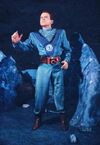
Frankie Thomas for all you Space Cadets out there.
Tom Corbett was the main character in a series of Tom Corbett — Space Cadet stories that were depicted in television, radio, books, comic books, comic strips, coloring books, punch-out books and View-Master reels in the 1950s. Harry Turtledove attended LACon IV, the 2006 Worldcon which would have had Frankie Thomas, Jr. the actor who portrayed Corbett as a guest. This event had Mike Resnick commission a series of space cadet stories for an anthology and led Turtledove to write "Someone is Stealing the Great Throne Rooms of the Galaxy" as a parody of the show.
In Joe Steele, Charlie Sullivan's son Pat was an enthusiastic watcher of the television program Tim Craddock, Space Cadet, a clear parody name of Tom Corbett.[57]
The Universal Monsters
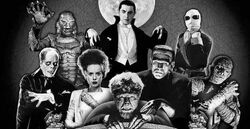
Who are you calling monsters?
Turtledove has directly or indirectly invoked several of the monster movies produced by Universal Studios. While many of these films were based on novels, Turtledove's characters appear far more familiar with the film versions.
The Frankenstein Monster is referenced in "Shtetl Days" (see Frankenstein (1931 film)). The same character is also used as a metaphor of a ragged, patched-up piece of equipment in other stories. Examples are found in the Days of Infamy series when Saburo Shindo puts together an airworthy Zero from several wrecks along with parts from wrecked Oscars, and in The War That Came Early: Hitler's War when Luc Harcourt wears a torn and stitched-up uniform.[58]
Bela Lugosi and his famous alter ego Dracula (from the 1931 adaptation of the Bram Stoker novel) are referenced several times throughout Worldwar and The War That Came Early, in connection with someone's foreign name or accent, or an encounter with blood-sucking insects. Another Lugosi role, Ygor, is the basis for the character Igor in "Father of the Groom".
Lon Chaney's turn as the Phantom of the Opera is referenced directly in The Man With the Iron Heart and is "butterflied" in Settling Accounts: The Grapple as the "Phantom of the Catacombs" (see also Gaston Leroux).
Lope de Vega
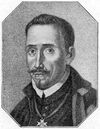
Lope de Vega: in Turtledove's hands, just a bit of a star-f*cker
Lope de Vega is one of two alternating POV characters in Ruled Britannia, along with William Shakespeare. During the course of the novel, Vega is seen working on two plays, La Dama Boba and El Mejor Mozo de España, which is performed live at one point in the book. Both plays were written by Lope de Vega in OTL, although years later than in the novel. The first one is a romantic comedy and the second a nationalist historical piece that, despite being named after King Ferdinand II of Aragon, actually lionises Queen Isabella I of Castile. In a way, both reflect on aspects of Lope de Vega's role in the novel. The first because Lope pursues selfish romantic interests and has to deal with a useless servant like many characters in the play's genre. The second because he is a member of the Spanish occupation army in England who keeps the country under another Queen Isabella, and oversees Shakespeare's crafting of a similarly lionising play for a Spanish king, King Philip, only to discover later that Shakespeare has been secretly writing another lionising, nationalistic play about a queen of his own country's past, Boudicca.
At one point, de Vega, who is a fluent though not a native speaker of English, contributes four iambs to Shakespeare's King Philip, and Shakespeare is inspired to create the fifth and add the line to the existing script.
Maurine Dallas Watkins
Maurine Dallas Watkins (1896-1969) was a journalist with the Chicago Tribune in the 1920s. During that time, she covered the murder trials of Belva Gaertner and Beulah Sheriff Annan. Both women were convicted. Watkins used these trials as inspiration for her play, Chicago (also known as Roxie Hart), which was adapted into a musical in the 1970s. In the novel Joe Steele, Turtledove directly references the Gaertner trial by making his Americanized version of Andrey Vyshinsky one of the prosecutors in the matter. He also notes that one of the reporters, implicitly Watkins, wrote a play based on the trial.[59]
In Laura Frankos Broadway-in-joke-heavy fantasy "Leg Irons, the Bitch and the Wardrobe," Polsiee is said to have starred in a "tawdry women's dungeon drama," probably a reference to Watkins' play and/or its musical adaptation. Later in the story, Polsiee shouts "He had it coming! He had it coming!", a refrain from one of the numbers in the musical.
Matthew Weiner
Matthew Weiner (born 1965) is the creator the cable series Mad Men, about the employees of an advertising agency in the 1960s. In the short story "The Eighth-Grade History Class Visits the Hebrew Home for the Aging", Anne Berkowitz notes that in a black-and-white photograph, her late husband looks Mad Men-y in a suit.
Orson Welles
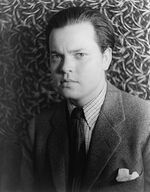
Yes, I'm the same man who will one day sell you wine and peas. Just remember me as I am now - Turtledove does.
George Orson Welles (1915-1985) was an American actor known for his cinema films including Citizen Kane (1941) and Falstaff (1965). Prior to that, he broadcast an adaptation of the H.G. Wells novel The War of the Worlds over the radio in October 1938. So realistic was the acting in this play about Martians attacking the United States, that audiences tuning in and catching snippets out of context, believed that a real invasion was occurring on a news program. The legends surrounding this broadcast have likely been exaggerated in the degree of how many people listened and what they believed; it is more probable that they took the enemy as very real Nazis rather than make-believe space monsters.
The Worldwar series' point of divergence comes when an actual alien invasion occurs just four years after Welles' broadcast. Sam Yeager references Welles' play and tells Mutt Daniels that "The Martians have landed, for real this time."[60]
In The Valley-Westside War, Crosstimer George Stoyadinovich initially uses the verbal command "Rosebud" for his safehouse in Speedro at first, on the theory that most natives of the alternate did not have access to Citizen Kane. However, subsequent events convince him to change it.[61]
References
- ↑ Departures, p. 167.
- ↑ The House of Daniel, pg. 8, ebook.
- ↑ In the Balance, p. 103, HC.
- ↑ Joe Steele, pg. 316, HC.
- ↑ Joe Steele, p. 427, HC.
- ↑ Down to Earth, pg. 162 and 403, HC.
- ↑ Last Orders, p. 103-104.
- ↑ In the Presence of Mine Enemies, pg. 139.
- ↑ Down to Earth, p. 206 PB, 163 HC.
- ↑ Joe Steele, p. 427, HC.
- ↑ The Two Georges, pgs. 164-165, MPB.
- ↑ West and East, pg. 84, HC.
- ↑ Two Fronts, Chapter 10.
- ↑ Days of Infamy, pgs. 376-7.
- ↑ Atlantis and Other Places, p. 423.
- ↑ Kaleidoscope, pg. 75, MPB.
- ↑ The Disunited States of America, p. 228
- ↑ A World of Difference, p. 209.
- ↑ Walk in Hell, pg. 46.
- ↑ Coup d'Etat ch 12
- ↑ Second Contact, pg. 360.
- ↑ Eruption, pg. 335, HC.
- ↑ Eruption, pg. 145.
- ↑ Kaleidoscope, pg. 125, MPB.
- ↑ Bombs Away, pg. 267, HC.
- ↑ Ibid., pgs. 309-310.
- ↑ Second Contact, pg. 78.
- ↑ The Man With the Iron Heart, pg. 185.
- ↑ Last Orders, pgs. 152-153, HC.
- ↑ West and East, pg. 202, HC.
- ↑ Joe Steele, p. 140
- ↑ See e.g. Counting Up, Counting Down, p. 125.
- ↑ Days of Infamy, p. 140.
- ↑ Hitler's War, pg. 73, 204.
- ↑ West and East, pg. 246.
- ↑ All Fall Down, pg. 204, HC.
- ↑ The Big Switch, p. 168.
- ↑ The Man With the Iron Heart, pg. 185.
- ↑ Tilting the Balance, p. 124, HC.
- ↑ The Gladiator, p. 276.
- ↑ Joe Steele, pg. 186.
- ↑ Coup d'Etat ch 12
- ↑ Redshift, p. 208.
- ↑ Departures, p. 182.
- ↑ The Man With the Iron Heart, pg. 20.
- ↑ Ibid., pg. 44, HC.
- ↑ All Fall Down, pg. 316, HC.
- ↑ Things Fall Apart, pg. 321, HC.
- ↑ All Fall Down, pgs. 34-37, HC.
- ↑ Joe Steele, pgs. 5-6, HC.
- ↑ Atlantis and Other Places, pg. 92.
- ↑ See, e.g., Departures, pg. 32.
- ↑ Fallout, p. 350
- ↑ Hitler's War, pg. 31.
- ↑ The Man With the Iron Heart, pg. 302.
- ↑ We Install and Other Stories, p. 131.
- ↑ Joe Steele, pg. 388, HC.
- ↑ Hitler's War, p. 295, HC.
- ↑ Joe Steele.
- ↑ In the Balance, pg. 47-8.
- ↑ The Valley-Westside War, p. 282-283.